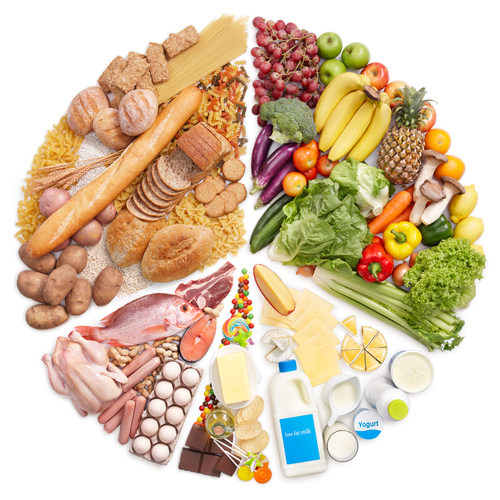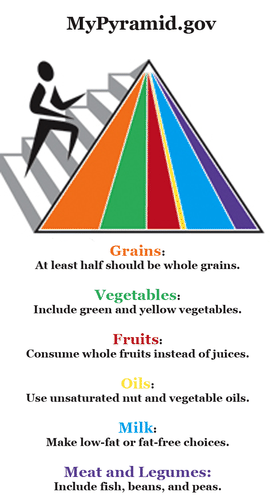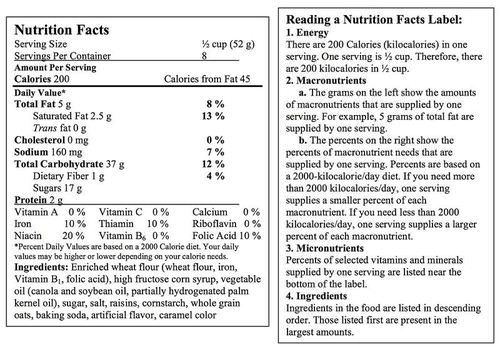13.34: Balanced Eating
- Page ID
- 13308
\( \newcommand{\vecs}[1]{\overset { \scriptstyle \rightharpoonup} {\mathbf{#1}} } \)
\( \newcommand{\vecd}[1]{\overset{-\!-\!\rightharpoonup}{\vphantom{a}\smash {#1}}} \)
\( \newcommand{\dsum}{\displaystyle\sum\limits} \)
\( \newcommand{\dint}{\displaystyle\int\limits} \)
\( \newcommand{\dlim}{\displaystyle\lim\limits} \)
\( \newcommand{\id}{\mathrm{id}}\) \( \newcommand{\Span}{\mathrm{span}}\)
( \newcommand{\kernel}{\mathrm{null}\,}\) \( \newcommand{\range}{\mathrm{range}\,}\)
\( \newcommand{\RealPart}{\mathrm{Re}}\) \( \newcommand{\ImaginaryPart}{\mathrm{Im}}\)
\( \newcommand{\Argument}{\mathrm{Arg}}\) \( \newcommand{\norm}[1]{\| #1 \|}\)
\( \newcommand{\inner}[2]{\langle #1, #2 \rangle}\)
\( \newcommand{\Span}{\mathrm{span}}\)
\( \newcommand{\id}{\mathrm{id}}\)
\( \newcommand{\Span}{\mathrm{span}}\)
\( \newcommand{\kernel}{\mathrm{null}\,}\)
\( \newcommand{\range}{\mathrm{range}\,}\)
\( \newcommand{\RealPart}{\mathrm{Re}}\)
\( \newcommand{\ImaginaryPart}{\mathrm{Im}}\)
\( \newcommand{\Argument}{\mathrm{Arg}}\)
\( \newcommand{\norm}[1]{\| #1 \|}\)
\( \newcommand{\inner}[2]{\langle #1, #2 \rangle}\)
\( \newcommand{\Span}{\mathrm{span}}\) \( \newcommand{\AA}{\unicode[.8,0]{x212B}}\)
\( \newcommand{\vectorA}[1]{\vec{#1}} % arrow\)
\( \newcommand{\vectorAt}[1]{\vec{\text{#1}}} % arrow\)
\( \newcommand{\vectorB}[1]{\overset { \scriptstyle \rightharpoonup} {\mathbf{#1}} } \)
\( \newcommand{\vectorC}[1]{\textbf{#1}} \)
\( \newcommand{\vectorD}[1]{\overrightarrow{#1}} \)
\( \newcommand{\vectorDt}[1]{\overrightarrow{\text{#1}}} \)
\( \newcommand{\vectE}[1]{\overset{-\!-\!\rightharpoonup}{\vphantom{a}\smash{\mathbf {#1}}}} \)
\( \newcommand{\vecs}[1]{\overset { \scriptstyle \rightharpoonup} {\mathbf{#1}} } \)
\(\newcommand{\longvect}{\overrightarrow}\)
\( \newcommand{\vecd}[1]{\overset{-\!-\!\rightharpoonup}{\vphantom{a}\smash {#1}}} \)
\(\newcommand{\avec}{\mathbf a}\) \(\newcommand{\bvec}{\mathbf b}\) \(\newcommand{\cvec}{\mathbf c}\) \(\newcommand{\dvec}{\mathbf d}\) \(\newcommand{\dtil}{\widetilde{\mathbf d}}\) \(\newcommand{\evec}{\mathbf e}\) \(\newcommand{\fvec}{\mathbf f}\) \(\newcommand{\nvec}{\mathbf n}\) \(\newcommand{\pvec}{\mathbf p}\) \(\newcommand{\qvec}{\mathbf q}\) \(\newcommand{\svec}{\mathbf s}\) \(\newcommand{\tvec}{\mathbf t}\) \(\newcommand{\uvec}{\mathbf u}\) \(\newcommand{\vvec}{\mathbf v}\) \(\newcommand{\wvec}{\mathbf w}\) \(\newcommand{\xvec}{\mathbf x}\) \(\newcommand{\yvec}{\mathbf y}\) \(\newcommand{\zvec}{\mathbf z}\) \(\newcommand{\rvec}{\mathbf r}\) \(\newcommand{\mvec}{\mathbf m}\) \(\newcommand{\zerovec}{\mathbf 0}\) \(\newcommand{\onevec}{\mathbf 1}\) \(\newcommand{\real}{\mathbb R}\) \(\newcommand{\twovec}[2]{\left[\begin{array}{r}#1 \\ #2 \end{array}\right]}\) \(\newcommand{\ctwovec}[2]{\left[\begin{array}{c}#1 \\ #2 \end{array}\right]}\) \(\newcommand{\threevec}[3]{\left[\begin{array}{r}#1 \\ #2 \\ #3 \end{array}\right]}\) \(\newcommand{\cthreevec}[3]{\left[\begin{array}{c}#1 \\ #2 \\ #3 \end{array}\right]}\) \(\newcommand{\fourvec}[4]{\left[\begin{array}{r}#1 \\ #2 \\ #3 \\ #4 \end{array}\right]}\) \(\newcommand{\cfourvec}[4]{\left[\begin{array}{c}#1 \\ #2 \\ #3 \\ #4 \end{array}\right]}\) \(\newcommand{\fivevec}[5]{\left[\begin{array}{r}#1 \\ #2 \\ #3 \\ #4 \\ #5 \\ \end{array}\right]}\) \(\newcommand{\cfivevec}[5]{\left[\begin{array}{c}#1 \\ #2 \\ #3 \\ #4 \\ #5 \\ \end{array}\right]}\) \(\newcommand{\mattwo}[4]{\left[\begin{array}{rr}#1 \amp #2 \\ #3 \amp #4 \\ \end{array}\right]}\) \(\newcommand{\laspan}[1]{\text{Span}\{#1\}}\) \(\newcommand{\bcal}{\cal B}\) \(\newcommand{\ccal}{\cal C}\) \(\newcommand{\scal}{\cal S}\) \(\newcommand{\wcal}{\cal W}\) \(\newcommand{\ecal}{\cal E}\) \(\newcommand{\coords}[2]{\left\{#1\right\}_{#2}}\) \(\newcommand{\gray}[1]{\color{gray}{#1}}\) \(\newcommand{\lgray}[1]{\color{lightgray}{#1}}\) \(\newcommand{\rank}{\operatorname{rank}}\) \(\newcommand{\row}{\text{Row}}\) \(\newcommand{\col}{\text{Col}}\) \(\renewcommand{\row}{\text{Row}}\) \(\newcommand{\nul}{\text{Nul}}\) \(\newcommand{\var}{\text{Var}}\) \(\newcommand{\corr}{\text{corr}}\) \(\newcommand{\len}[1]{\left|#1\right|}\) \(\newcommand{\bbar}{\overline{\bvec}}\) \(\newcommand{\bhat}{\widehat{\bvec}}\) \(\newcommand{\bperp}{\bvec^\perp}\) \(\newcommand{\xhat}{\widehat{\xvec}}\) \(\newcommand{\vhat}{\widehat{\vvec}}\) \(\newcommand{\uhat}{\widehat{\uvec}}\) \(\newcommand{\what}{\widehat{\wvec}}\) \(\newcommand{\Sighat}{\widehat{\Sigma}}\) \(\newcommand{\lt}{<}\) \(\newcommand{\gt}{>}\) \(\newcommand{\amp}{&}\) \(\definecolor{fillinmathshade}{gray}{0.9}\)
Why is the good stuff in the smallest segment of this diagram?
If you're like most high school kids, one of the first things you do after school is search for something to eat. And you look for the chips or candy. As this diagram shows, you can eat those. Just not a lot.
Balanced Eating
Balanced eating is a way of eating that promotes good health. It means eating the right balance of different foods to provide the body with all the nutrients it needs. Fortunately, you don’t need to measure and record the amounts of different nutrients you each day in order to balance your eating. Instead, you can use MyPlate, MyPyramid, and food labels.
MyPyramid and MyPlate
MyPyramid shows the relative amounts of foods in different food groups you should eat each day (see Figure below).
 MyPyramid is a visual guideline for balanced eating.
MyPyramid is a visual guideline for balanced eating.Each food group represented by a colored band in MyPyramid is a good source of nutrients. The key in Figure above shows the food group each band represents. The wider the band, the more you should eat from that food group. The white tip of MyPyramid represents foods that should be eaten only once in a while, such as ice cream and potato chips. They contain few nutrients and may contribute excess Calories to the diet.
The figure “walking” up the side of MyPyramid represents the role of physical activity in balanced eating. Regular exercise helps you burn any extra energy that you consume in foods and provides many other health benefits. You should be active for about an hour a day most days of the week. The more active you are, the more energy you will use.
In June 2011, the United States Department of Agriculture replaced My Pyramid with MyPlate. MyPlate depicts the relative daily portions of various food groups. See http://www.choosemyplate.gov/ for further information.
 MyPlate is a visual guideline for balanced eating, replacing MyPyramid in 2011.
MyPlate is a visual guideline for balanced eating, replacing MyPyramid in 2011.The following guidelines accompany MyPlate:
- Balancing Calories
- Enjoy your food, but eat less.
- Avoid oversized portions.
- Foods to Increase
- Make half your plate fruits and vegetables.
- Make at least half your grains whole grains.
- Switch to fat-free or low-fat (1%) milk.
- Foods to Reduce
- Compare sodium in foods like soup, bread, and frozen meals - and choose the foods with lower numbers.
- Drink water instead of sugary drinks.
Food Labels
Packaged foods are required by law to carry a nutrition facts label, like the one in Figure below. The labels show the nutrient content and ingredients of foods. Reading labels can help you choose foods that are high in nutrients you need more of (such as proteins) and low in nutrients you need less of (such as fats).
 Nutrition facts labels like this one can help you make good food choices.
Nutrition facts labels like this one can help you make good food choices.You should also look for ingredients such as whole grains, vegetables, and fruits. Avoid foods that contain processed ingredients, such as white flour or white rice. Processing removes nutrients. As a result, processed foods generally supply fewer nutrients than whole foods, even when they have been enriched or fortified with added nutrients.
Weight Gain and Obesity
Any unused energy in food, whether it comes from carbohydrates, proteins, or lipids, is stored in the body as fat. An extra 3,500 Calories of energy results in the storage of almost half a kilogram (1 pound) of stored body fat. People who consistently consume more food energy then they need may become obese. Obesity occurs when the body mass index is 30.0 kg/m2 or greater. Body mass index (BMI) is an estimate of the fat content of the body. It is calculated by dividing a person’s weight (in kilograms) by the square of the person’s height (in meters). Obesity increases the risk of health problems such as type 2 diabetes and hypertension.
Eating Disorders
Some people who are obese have an eating disorder, called binge eating disorder, in which they compulsively overeat. An eating disorder is a mental illness in which people feel compelled to eat in a way that causes physical, mental, and emotional health problems. Other eating disorders include anorexia nervosa and bulimia nervosa. Treatments for eating disorders include counseling and medication.
Summary
- Balanced eating promotes good health.
- MyPlate, MyPyramid, and food labels are tools that can help you choose the right foods for balanced eating.
- Eating too much and exercising too little can lead to weight gain and obesity.
- Some people who are obese have an eating disorder. Eating disorders are mental illnesses that require treatment by health professionals.
Review
- Explain how to use MyPyramid and food labels to choose foods for balanced eating.
- What is an eating disorder? Give an example.
- Aleesha weighs 80 kg and is 1.6 m tall. What is her body mass index? Is she obese?
| Image | Reference | Attributions |
 |
[Figure 1] | [Figure 1] |
 |
[Figure 2] | Credit: Courtesy of MyPyramid.gov Source: www.mypyramid.gov/ License: Public Domain |
 |
[Figure 3] | Credit: Courtesy of the U.S. Department of Agriculture Source: http://www.choosemyplate.gov/ License: Public Domian |
 |
[Figure 4] | Credit: CK-12 Foundation Source: CK-12 Foundation License: CC BY-NC 3.0 |

